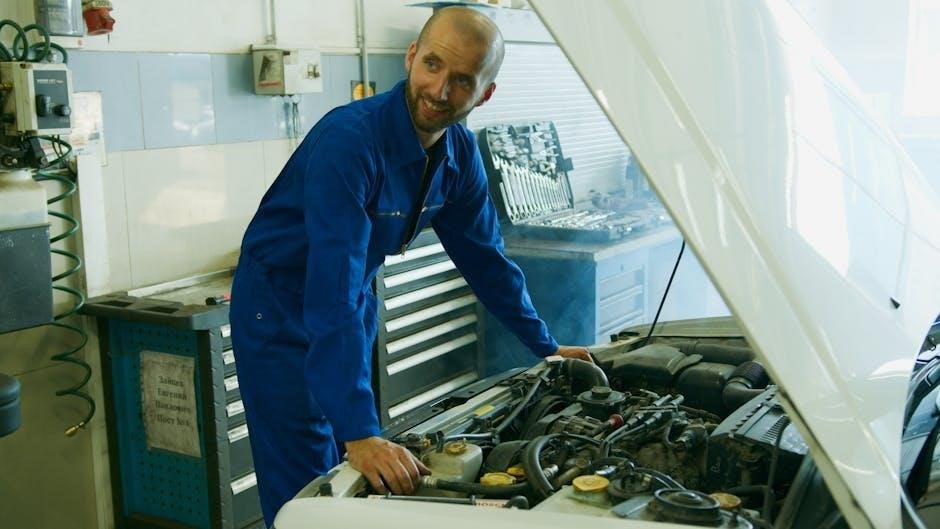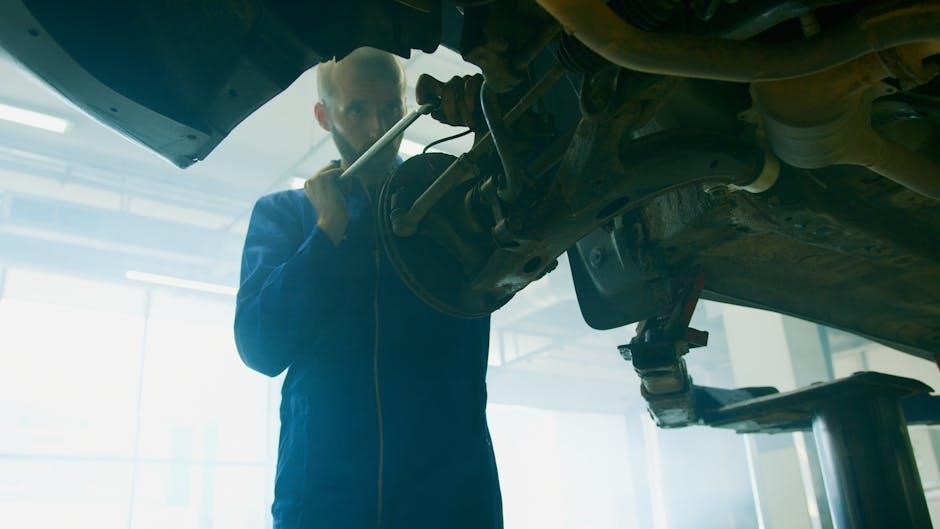
Welcome to the Whirlpool WTW5000DW1 Diagnostic Manual‚ your comprehensive guide to understanding and troubleshooting your top-load washer․ This manual covers diagnostic test modes‚ error codes like F7E5 (shifter fault) and F5E2 (lid lock fault)‚ and step-by-step repair solutions․ Designed for both homeowners and technicians‚ it empowers you to identify and resolve issues efficiently‚ ensuring optimal performance and extending the lifespan of your appliance․
Understanding the Diagnostic Test Mode
The Diagnostic Test Mode on the Whirlpool WTW5000DW1 washer is a valuable tool for identifying and troubleshooting issues․ This mode allows users to run specific tests that target various components and functions‚ such as the spin and agitate cycles․ By activating this mode‚ you can determine if problems like the F7E5 shifter fault or F5E2 lid lock fault are present․ The process typically involves a sequence of button presses on the control panel‚ often requiring you to hold down specific buttons for a few seconds after unplugging the washer or during startup․
Once activated‚ the washer may display error codes or flash lights to indicate specific issues․ Understanding these codes is crucial for diagnosing the problem accurately․ The Diagnostic Test Mode is not only useful for technicians but also for homeowners who want to take a proactive approach to maintenance․ Early detection of faults can prevent more severe damage and reduce repair costs․ This feature empowers users to identify issues early‚ making the troubleshooting process more efficient and straightforward․ By utilizing the Diagnostic Test Mode‚ you can ensure your washer operates at its best‚ extending its lifespan and maintaining optimal performance․
Common Error Codes: F7E5 and F5E2
The Whirlpool WTW5000DW1 washer often displays specific error codes to indicate issues that need attention․ Two of the most common codes are F7E5 and F5E2․ The F7E5 error code typically signifies a “shifter fault‚” which occurs when the washer’s transmission or gear system fails to shift properly between agitate and spin modes․ This can result in the washer not spinning or agitating as expected․ On the other hand‚ the F5E2 error code indicates a “lid lock fault‚” meaning the lid lock mechanism is not functioning correctly․ This prevents the washer from starting or completing a cycle‚ as the lid must be securely locked for safety reasons․

To address these issues‚ start by unplugging the washer and checking for any obstructions or debris in the lid lock mechanism for F5E2․ For F7E5‚ ensure the shifter and motor connections are clean and free from corrosion․ If these steps don’t resolve the problem‚ professional assistance may be required․ Understanding these codes is essential for effective troubleshooting and maintaining your washer’s performance․ Regular maintenance can help prevent these issues from arising‚ ensuring smooth operation and extending the appliance’s lifespan․
Troubleshooting Common Issues
Troubleshooting your Whirlpool WTW5000DW1 washer involves identifying and addressing common problems that may arise during its operation․ One of the first steps is to ensure the washer is properly plugged in and that the power supply is stable․ If the washer does not start‚ check the circuit breaker or fuse box to confirm power is being supplied․ Another common issue is improper loading‚ as overloading or underloading the washer can lead to imbalance and poor performance during cycles․

- If the washer is making unusual noises‚ inspect the tub for loose objects or debris․
- Excessive vibration may indicate uneven installation; ensure the washer is leveled correctly․
- If water does not drain properly‚ check the drain hose for kinks or blockages․
- For issues with detergent dispensers‚ clean the dispenser regularly to prevent clogs․
Regularly cleaning the gasket and drain pump filter can also prevent mold buildup and odor issues․ Always refer to the diagnostic manual for specific guidance‚ as some problems may require advanced troubleshooting techniques․ By addressing these common issues promptly‚ you can extend the lifespan of your washer and maintain its efficiency․
Accessing the Diagnostic Mode: A Step-by-Step Guide

To access the diagnostic mode on your Whirlpool WTW5000DW1 washer‚ follow these steps:
- Ensure the washer is in standby mode (plugged in but not running a cycle)․
- Press and hold the Start/Stop button for 3 seconds to wake up the control panel․
- Release the Start/Stop button‚ then press and hold the Soil Level button for 5 seconds․
- While holding the Soil Level button‚ press and release the Start/Stop button twice․
- Release the Soil Level button․ The washer will enter diagnostic mode‚ indicated by a beep or a specific display pattern․

Once in diagnostic mode‚ you can navigate through different test options using the control panel․ The display will show fault codes or test modes․ Use the Cycle or Options buttons to scroll through available tests․ To exit diagnostic mode‚ press and hold the Start/Stop button for 3 seconds or unplug the washer․
Always unplug the washer before performing any repairs to ensure safety․ Use this mode to identify issues or test components like the motor‚ water valves‚ or lid lock․ Refer to the manual for specific fault code interpretations․
Understanding the Diagnostic Display
The diagnostic display on the Whirlpool WTW5000DW1 washer provides critical information to help identify and resolve issues․ When in diagnostic mode‚ the display will show fault codes‚ test modes‚ or component statuses․ The LCD screen will typically display a combination of letters‚ numbers‚ or symbols to indicate specific conditions․
Fault codes are usually represented by a two-letter and two-number combination (e․g․‚ F7E5 or F5E2)․ These codes correspond to specific issues‚ such as sensor malfunctions or communication errors․ The display may also show test modes‚ allowing you to manually activate components like the spin motor or water valves for troubleshooting․
To interpret the display‚ refer to the diagnostic manual for code definitions․ The manual will explain what each code means and the recommended steps to address it․ For example‚ a flashing light or specific symbol may indicate a lid lock issue or an imbalance detection․ Understanding the display ensures accurate diagnostics and repairs․
Technicians and homeowners can use the diagnostic display to quickly identify problems without disassembling the washer․ Always consult the manual for detailed explanations of display messages to ensure proper troubleshooting and maintenance․
Interpreting Fault Codes
Fault codes on the Whirlpool WTW5000DW1 washer are essential for identifying specific issues․ These codes‚ such as F7E5 or F5E2‚ appear on the display during diagnostic mode and indicate problems like sensor malfunctions or communication errors․ Each code corresponds to a particular component or system failure‚ allowing for targeted troubleshooting․
To interpret fault codes‚ refer to the diagnostic manual‚ which provides detailed explanations․ For example‚ F7E5 may indicate a motor issue‚ while F5E2 could point to a water temperature sensor problem․ Understanding these codes helps diagnose issues accurately without unnecessary disassembly․

After identifying the fault code‚ follow the manual’s instructions for resolving the issue․ This may involve replacing faulty components or resetting the system․ Always clear the fault code after repairs to ensure the washer operates correctly․ Accurate interpretation of fault codes ensures efficient and effective maintenance․
Manual Test Modes for Spin and Agitate
The Whirlpool WTW5000DW1 washer features manual test modes designed to evaluate the spin and agitate functions independently․ These modes are invaluable for diagnosing issues related to the motor‚ gearbox‚ or belt․ By activating the spin test mode‚ you can observe the tub’s rotation speed and balance․ Similarly‚ the agitate test mode allows you to check the movement of the agitator or impeller‚ ensuring it operates smoothly and consistently․
To access these modes‚ follow the steps outlined in the diagnostic manual․ Typically‚ this involves pressing a combination of buttons on the control panel while in diagnostic mode․ Once activated‚ the washer will perform a series of predefined tests․ For instance‚ the spin mode may run at different speeds‚ while the agitate mode may simulate a wash cycle without water․
These test modes help identify issues such as uneven spin‚agitator jams‚ or motor malfunctions․ If the washer fails to perform as expected‚ it may indicate a faulty part that requires replacement․ Always refer to the manual for specific instructions and safety guidelines when using these diagnostic tools․ Regular use of these test modes can help maintain the washer’s performance and prevent unexpected breakdowns․
Calibration Steps Post Repair
After completing any repairs on your Whirlpool WTW5000DW1 washer‚ proper calibration is essential to ensure optimal performance․ Calibration helps the washer recognize new parts and restores its operational accuracy․ Start by ensuring the washer is in diagnostic mode‚ as outlined in the manual․ Once in diagnostic mode‚ navigate to the calibration menu using the control panel buttons․
Next‚ select the appropriate calibration option for the specific component repaired‚ such as the motor or gearbox․ The washer will then guide you through a series of automatic tests to recalibrate its systems․ Pay close attention to any prompts or indicators on the display‚ as these will confirm the calibration process is underway․
After calibration is complete‚ run a test cycle to verify the washer’s operation․ Check for smooth spinning‚ consistent agitation‚ and proper water levels․ If any issues persist‚ consult the manual or repeat the calibration process․ Proper calibration ensures the washer operates efficiently and prevents future malfunctions․ Always follow the manual’s instructions carefully to avoid errors during this critical step․ Calibration is a straightforward process that ensures your Whirlpool washer functions like new after repairs․
Maintenance Tips to Prevent Future Issues
Regular maintenance is key to extending the lifespan of your Whirlpool WTW5000DW1 washer and preventing unnecessary repairs․ Start by checking and cleaning the detergent dispenser regularly to remove residue buildup․ Leave the washer lid open after cycles to allow the interior to dry‚ reducing mold and mildew growth․

Inspect the water supply hoses for signs of wear or leaks and replace them if necessary․ Drain the water supply lines during freezing temperatures to prevent damage․ Run a cleaning cycle with a washer cleaner or vinegar to remove odors and residue from the tub․ Ensure the washer is properly balanced during installation to avoid excessive vibrations․

For long-term maintenance‚ schedule an annual checkup with a professional to inspect internal components like the belt and gearbox․ Clean the drain pump filter monthly to prevent blockages․ By following these simple steps‚ you can keep your Whirlpool washer running smoothly and avoid costly repairs․ Regular upkeep ensures reliability and longevity․
Addressing the Lid Lock Fault
A lid lock fault‚ often indicated by error codes like F7E5 or F5E2‚ occurs when the washer detects an issue with the lid lock mechanism․ This can prevent the washer from operating․ To address this‚ start by ensuring the lid is properly aligned and closed․ Check for obstructions like clothing or debris that may prevent the lid from locking securely․
If the issue persists‚ reset the washer by unplugging it for 30 minutes to clear any temporary glitches․ Next‚ inspect the lid lock assembly for damage or wear․ Clean the lid lock sensor to ensure proper detection․ If the problem remains‚ the lid lock or strike may need replacement․
Refer to the diagnostic manual for guidance on disassembling the washer to access the lid lock components․ Always disconnect power before attempting repairs․ If you’re unsure‚ consult a professional technician․ Regular maintenance and ensuring the lid aligns correctly can help prevent future lid lock faults․ By addressing this issue promptly‚ you can restore your washer’s functionality and avoid further complications․
Resolving the Shifter Fault
A shifter fault in the Whirlpool WTW5000DW1 washer is typically indicated by error codes such as F7E5 or F5E2‚ which signal a problem with the shifter mechanism․ This component is responsible for engaging the gears during different wash cycles․ To resolve this issue‚ start by ensuring the washer is properly leveled‚ as an uneven surface can disrupt the shifter’s operation․
Next‚ check for any blockages in the tub or basket that might interfere with the shifter’s movement․ Run a diagnostic test mode to confirm the fault․ If the issue persists‚ inspect the shifter assembly for signs of wear or damage․ Clean or replace faulty parts as needed․ In some cases‚ the shifter may need recalibration or replacement entirely․

Always disconnect power before attempting repairs․ If the problem is beyond basic troubleshooting‚ consult the diagnostic manual for detailed instructions or contact a certified technician․ Addressing the shifter fault promptly ensures smooth operation and prevents further damage to the washer’s internal components․ Regular maintenance can also help avoid such issues in the future․
Resetting the Washer
Resetting the Whirlpool WTW5000DW1 washer is a straightforward process that can resolve minor glitches or restore default settings․ To perform a reset‚ unplug the washer from the power outlet and press and hold the Start button for approximately 10 seconds․ This action clears any temporary errors in the control board memory․ After releasing the button‚ plug the washer back in and allow it to restart․

This method does not erase custom settings or calibration data but ensures the washer operates with a clean slate․ Resetting is particularly useful after repairing or replacing components‚ as it allows the system to recognize new parts․ Always ensure the washer is empty and properly balanced before resetting to avoid unnecessary issues․
If the washer continues to malfunction after a reset‚ refer to the diagnostic manual for further troubleshooting steps or consider consulting a professional technician․ Resetting is a safe and effective first step in addressing operational irregularities․
Using the Manual for Advanced Diagnostics
The Whirlpool WTW5000DW1 diagnostic manual is an essential tool for advanced diagnostics‚ offering in-depth guidance for technicians and experienced users․ It provides detailed procedures for identifying and addressing complex issues that may not be apparent through basic troubleshooting․ By leveraging the manual‚ users can access specialized test modes‚ interpret advanced fault codes‚ and perform intricate system checks․
The manual is structured to help users navigate the diagnostic process efficiently‚ with clear instructions for accessing and utilizing the control board’s advanced features․ It also includes detailed wiring diagrams and component tests‚ enabling precise identification of faulty parts․ For those familiar with appliance repair‚ the manual serves as a comprehensive resource to ensure accurate and efficient fixes․
Advanced diagnostics often require a deep understanding of the washer’s internal systems‚ and the manual bridges this gap by providing step-by-step directions․ Regularly referencing the manual ensures that repairs are performed safely and effectively‚ minimizing the risk of further damage or malfunctions․ It is a vital resource for anyone aiming to resolve complex issues and restore optimal performance to the Whirlpool WTW5000DW1․
Safety Precautions During Diagnosis
When working with the Whirlpool WTW5000DW1 diagnostic manual‚ it is crucial to follow safety precautions to avoid injury or damage․ Always unplug the washer from the power source before attempting any repairs or diagnostics to eliminate the risk of electric shock․ Ensure the machine is cool and dry‚ as moving parts or residual heat can pose hazards․
Wear protective gear‚ such as gloves and safety glasses‚ to safeguard against sharp edges or debris․ Never bypass safety features or override the lid lock mechanism‚ as this can lead to serious accidents․ If water is present‚ avoid contact with electrical components to prevent shock or short circuits․
Use only authorized tools and follow the manual’s instructions precisely․ Do not attempt repairs beyond your skill level‚ as improper procedures can result in further damage or safety risks․ If unsure about a step‚ consult a professional technician․ Always refer to the manual for specific safety guidelines related to your diagnosis or repair task․
By adhering to these precautions‚ you can ensure a safe and effective diagnostic process for the Whirlpool WTW5000DW1․ Safety should always be the top priority when working with electrical appliances․
Recommended Resources for Further Assistance
For comprehensive support with the Whirlpool WTW5000DW1‚ several resources are available to assist with diagnostics‚ repairs‚ and maintenance․ The official Whirlpool website provides detailed product information‚ manuals‚ and troubleshooting guides․ Additionally‚ authorized Whirlpool service centers offer expert assistance and genuine parts‚ ensuring reliable solutions․ For DIY enthusiasts‚ websites like RepairClinic and iFixit provide repair guides‚ replacement parts‚ and step-by-step instructions specific to the WTW5000DW1 model․
Online forums and communities‚ such as ApplianceBlog‚ are invaluable for sharing experiences and solutions from other users and technicians․ YouTube channels dedicated to appliance repair often feature tutorials and troubleshooting tips for common issues․ For advanced diagnostics‚ the Whirlpool WTW5000DW1 service manual is an essential resource‚ offering in-depth technical details and repair procedures․
Lastly‚ Whirlpool’s customer support hotline is available for direct assistance with specific questions or concerns․ Leveraging these resources ensures you have access to the tools and knowledge needed to resolve issues effectively․
The Whirlpool WTW5000DW1 diagnostic manual is an indispensable tool for diagnosing and resolving issues with your washing machine․ By understanding the diagnostic test mode‚ interpreting fault codes‚ and following step-by-step troubleshooting procedures‚ you can address common problems effectively․ Regular maintenance and proactive troubleshooting can significantly extend the lifespan of your appliance and prevent costly repairs․
This guide empowers you to take control of routine maintenance and minor repairs‚ saving time and money․ For more complex issues‚ consulting the manual or reaching out to a certified technician ensures safety and efficiency․ By familiarizing yourself with the diagnostic features and calibration processes outlined in this manual‚ you can confidently maintain your Whirlpool washer and keep it running at peak performance for years to come․
- Regularly check and maintain your washer to prevent future issues․
- Refer back to this manual for troubleshooting common faults․
- Consult official Whirlpool resources or professionals when needed․
With the knowledge provided‚ you’re well-equipped to handle diagnostics and repairs efficiently‚ ensuring your Whirlpool WTW5000DW1 continues to function optimally․